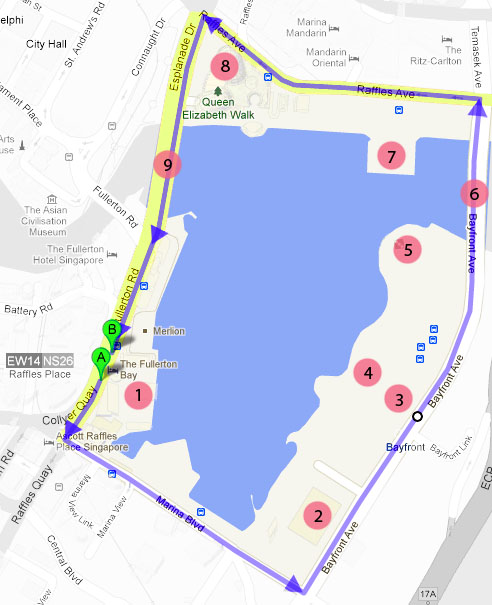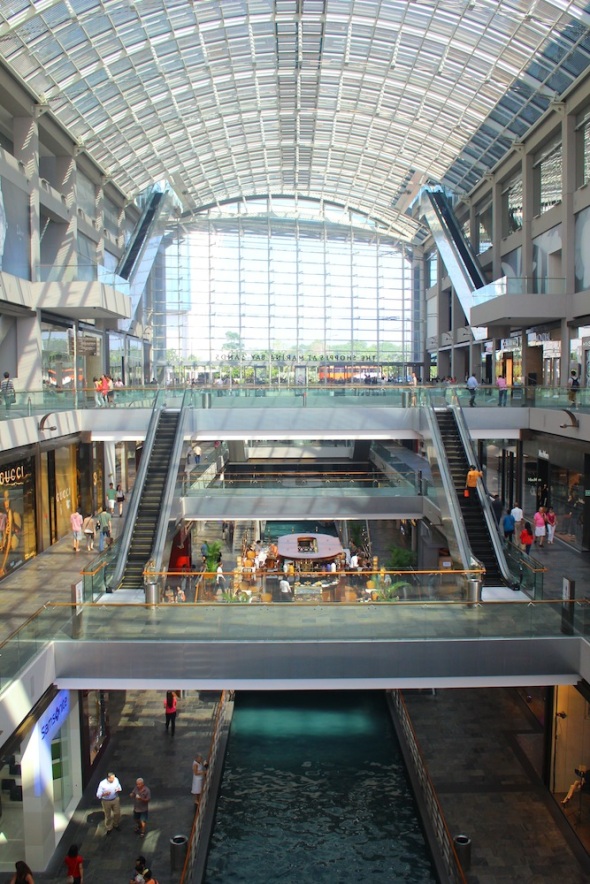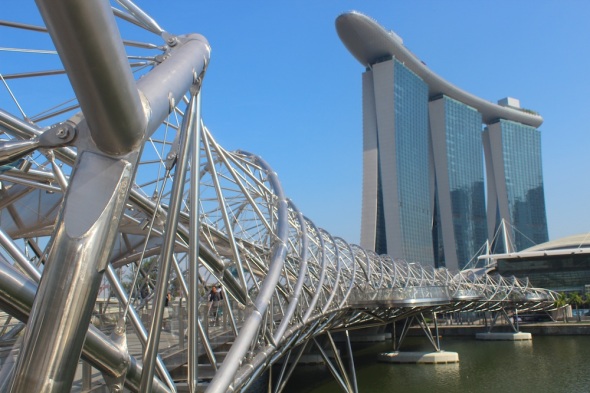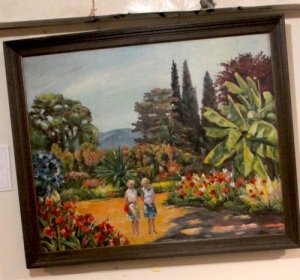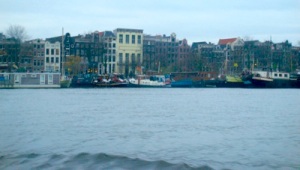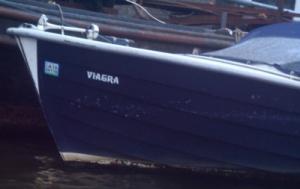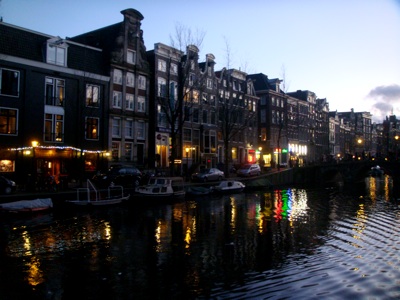Travel: A Brief Photo Walk of Marina Bay (SINGAPORE)
Posted: September 22, 2012 Filed under: Photography, Tourist Attractions, Travel | Tags: Marina Bay, Singapore, tourism, travel, walk Leave a commentI love exploring cities just by walking around, and from what I’ve gathered so far, Singapore the perfect place for that. Its transport system is one of the most advanced in the world, but the sun is shining and there are lots to see on foot. I was lucky enough to stay at the gorgeous Fullerton Bay Hotel on my last visit here, and so decided to make the most of it by exploring the Marina Bay area. Here is a map of the route I took, which took about 50 minutes in total:
The Fullerton Bay Hotel is the newer, more modern sister of The Fullerton, which is located just across the road. Although the Bay branch is slightly smaller in size, it is by no means less superior. Our room had a private balcony with a lovely view, breakfast was always delicious, and the staff were all very polite and helpful. But its best hidden little secrets lie on the rooftop: the pools. There is one big pool with deck chairs and little tables laid out along the shallowest side, and two smaller jacuzzi infinity pools that show off one of the best views of Marina Bay. On a lucky day you may even get the entire little pool to yourself – bliss!
Singapore is very proud of its urban planning – and with good reasons. While most buildings located on prominent skylines around the world all try to compete against and outdo each other, the ones here seem to coexist in harmony. This is mostly owing to the careful and sometimes very strict hands of the Urban Redevelopment Authority (URA). There are two City Galleries in Singapore, and while the one in Tanjong Pagar is no doubt more impressive (keep an eye out for an article on this that will be coming soon!), the Marina Bay branch nonetheless provides a quick and interesting insight into the island’s city planning strategies.
The Marina Bay Sands, which opened in 2011, is one of the world’s most expensive casino resorts. Developed by American firm Las Vagas Sands, the building is quite something to behold, boasting over 2000 rooms and the biggest elevated infinity pool on the planet. It also takes part in the nightly Wonder Full light show, during which lasers beam across the Bay to music. Apart from the hotel, the Sands also comprises of a huge convention centre, two theatres, a string of high-end restaurants and a shopping mall amongst other features.
4. The Shoppes at Marina Bay Sands
With 800,000 square feet of retail space, The Shoppes is a self-dubbed ‘shopping mecca’. It is home to pretty much every luxury brand as well as some newer emerging labels. There are also cafes and restaurants to rest tired feet, and an ice rink for the more adventurous (although its floor is actually made of cold plastic rather than real ice). But its most unique feature is probably the Sampan ride, inspired perhaps by The Venetian Macao. For S$10 per person, visitors may enjoy a mini boat trip around the mall, which includes an up close and personal view of Ned Kahn’s waterfall art piece ‘Rain Oculus’.
The lotus-shaped ArtScience Museum is yet another part of the Marina Bay Sands. Being spoilt by free shows in England, I was a bit disappointed to find that the exhibitions here all require an admission fee, although they certainly look very impressive. There is currently a Harry Potter and an Andy Warhol show going on, which will be there until 30th September and 21st October respectively. The museum consists of 21 galleries and has a total floor space of 50,000 square feet.
6. Helix Bridge
The Helix Bridge offers a spectacular view of Marina Bay, especially at the four designated viewing pods. A joint venture between Australian and Singaporean architects, the bridge’s design keeps the city-state’s temperamental weather in mind, so that its users are sheltered from both the scorching sun and heavy rain. Its unique and complex shape follows the double-helix structure of the DNA, and if you look closely you’ll find that there are pairs of alphabetic letters along the floor, which are actually meant to represent the base pairs of nucleic acid!
7. The Float@Marina Bay
The world’s largest floating stadium, The Float@Marina Bay, is where the Singapore National Day Parades have been taking place since 2007. It can fit 30,000 seated spectators and can support over 1,000 tonnes. The platform also hosted the Opening and Closing Ceremonies of the Singapore Youth Olympic Games in 2010 amongst other major – mostly sporting – events.
8. Esplanade
Nicknamed ‘The Durian’ in reference to the tropical fruit due to the shape of its exterior, Esplanade is Singapore’s most prominent stage and music venue. There are two main performing spaces – a theatre and a concert hall – with another Outdoor Theatre right by the waterfront for free open air shows. Aside from being a centre for the arts, Esplanade also has a bunch of restaurants and quirky shops for the casual walk-in visitor.
9. Esplanade Bridge
Finally, to end our walk, we crossed the flower-clad Esplanade Bridge to get back to the Fullerton Bay. The Merlion Park lies at the end of the bridge, where a huge statue of Singapore’s mascot – a mythical creature with a lion’s head and a mermaid’s tail – stands tall. A two-meter Merlion cub may also be found next to it. If you go at the right time (which we didn’t) you will even get to see the big Merlion spouting water from its mouth as a symbol of prosperity.
* ** *** ** *
Check out Marina Bay’s official website for more info about what to do in the area!
Museum of Bad Art (MOBA), (BOSTON, MA, USA)
Posted: March 31, 2012 Filed under: Art, Interviews, Tourist Attractions, Travel | Tags: America, art, Bad, Boston, Gallery, Louise Sacco, Massachusetts, Mike Frank, museum Leave a commentADDRESSES:
Basement of Dedham Community Theatre
580 High Street
Dedham MA 02026 (map)
Basement of Somerville Theatre
55 Davis Square
Somerville MA 02144 (map)
BATV
46 Tappan St., Top Floor
Brookline MA 02445 (map)
PHONE: 1.781.444.6757
WEBSITE: www.museumofbadart.org
Free entry. The Dedham and Somerville branches are open whenever films are showing at the theatres, and the Brookline branch is open during BATV opening times.
MY SHORT STORY:
- Instead of being offensively terrible, the art displayed in the Museum of Bad Art (MOBA) is endearingly ‘too bad to be ignored.’
- The museum is a non-profit organisation that is free to the public. It started when an arts and antique dealer called Scott Wilson found a painting now known as ‘Lucy in the Sky with Flowers’ in a pile of rubbish on the roadside in 1993. His friend Jerry Reilly liked it so much that he insisted on keeping it. The two guys, with a little help from three other friends and family members, set up MOBA in Jerry’s basement. They moved to the basement of Dedham Community Theatre the following year, and two branches in Brookline and Somerville opened a few years ago.
- I had a chance to meet Mike Frank, MOBA’s current Curator, and Louise Sacco, one of the museum’s original founders and current Executive Director. They told me that sincerity and originality are factors they look for in the paintings they choose to display, not unlike the criteria used to select works in traditional galleries. The works have to have started off as a serious attempt that went wrong for whatever reason. They like all paintings on display.
- Mike and Louise insist that they are not out to offend anyone, but rather to mock the pretentious artspeak used by art critics.
- I personally really love the paintings, as they are all insane but still pretty and quirky. You can’t help but wonder just what the artists were thinking when they made these works. It’s really interesting finding out the stories behind them.
- MOBA is a magical and cheerful place for second chances, and breathes new life into abandoned pieces with lighthearted humour. I love it!
MY FULL STORY: As some of you may have read in my Northern Art Prize and other articles, I have been getting quite angry about what Art seems to have come to become these days. It’s as though anyone can create any piece of crap and as long as it is prettily framed it can sit quite comfortably on a stately gallery wall.

Clockwise from left: 'Bone-Juggling Dog in a Hula Skirt' by Mari Newman; 'He was a Friend of Mine' by Jack Owen; 'Jerez the Clown' by Higgins. Photo by Gwen Pew, Apr 2012.
So is there such thing as ‘bad art’? My answer lies in three wonderfully underground locations around Boston, Massachusetts – the tongue-in-cheekily named Museum of Bad Art (MOBA). But instead of being disgusted by the works on display, I was actually very attracted to them when I visited their Brookline and Somerville branches, perhaps because they aren’t pretentious at all. There is actually something very endearing and quirky about each painting.
Take Mari Newman’s ‘Bone-Juggling dog in a Hula Skirt,’ one of the museum’s resident heroes children usually love. It is an explosion of nonsensical madness on canvas, but you can’t help loving the dog’s playful expression and wonder just what the artist was thinking when she created this.
As it turns out, in case you were wondering the same thing, Newman had originally wanted to just paint a wiener dog standing upright. When the attempt failed however, she decided to add random things to it, including a hula skirt (inspired by girls in a magazine) and dog bones being juggled (inspired by a visit to the pet store).
Gisela Keller’s ‘Elián Gonález’s Grandmothers’ is another favourite of mine. The garden in the painting is stunningly painted, as are the two ladies strolling in it – and yet something doesn’t quite fit. For one thing, they seem to be slightly too small for their surroundings. For another, they have no shadows, so they are literally just floating in the landscape. Still, it doesn’t detract from the fact that it’s beautiful on a very basic level.
‘The way that we select our works is actually very similar to traditional galleries,’ explained Louise Sacco, one of the original founders and now the Executive Founders of MOBA. ‘We still look for originality, sincerity… we have very strict criteria.’
Mike Frank, MOBA’s Curator, agrees sincerity is an important factor and that they have to feel drawn to the works.

Mike Frank, MOBA's Curator, chosen apparently because he was the museum's most generous donor - and he owns a tux. Photo by Gwen Pew, Apr 2012.
‘We like all of them. If we don’t then why would we put them on display?’ asked Mike.
More a labour of love than anything else, MOBA is a non-profit organisation that runs purely on donations, book sales and the generosity of bad art lovers and supporters.
The variety of art on show all have their own stories and origins. Some are donated by the artists directly, but most are ‘rescued,’ as Louise likes to call it, from thrift shops or rubbish dumps.
So what counts as bad art?
‘I think the terms ‘good’ and ‘bad’ art are problematic,’ Mike said. ‘The works on display at traditional galleries are important. The ones you get here are just a bit off, for one reason or another. You won’t find them anywhere else.’
‘They have to have started off as a serious attempt,’ Louise agreed. ‘But went wrong either because it was a bad concept in the first place or that it was just poorly executed.’
The story of MOBA began in 1993 when an arts and antiques dealer called Scott Wilson found a painting – now known affectionately as ‘Lucy in the Sky with Flowers’ – in a pile of rubbish on the roadside. He had originally only wanted the frame to sell as antique, but when he showed it to his friend Jerry Reilly, Jerry insisted on keeping the whole thing.
And so ‘Lucy’ was hung along with other acquired works in Jerry’s basement for a year, managed by Scott, Jerry, Jerry’s wife Marie Jackson, sister Louise Sacco, and their late photographer friend Tom Stankowicz. By 1994 the makeshift gallery had acquired a fair bit of fame and media coverage, and they moved to a somewhat more formal home – the basement of the Dedham Community Theatre, where it still stands now.
Their Somerville and Brookline galleries opened a few years ago, and the three galleries are now popular local attractions.
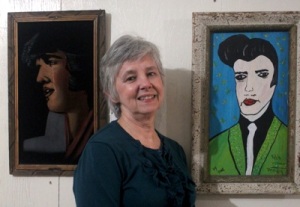
Louise Sacco, one of the Founding Fives of MOBA and current Executive Director. Photo by Gwen Pew, Apr 2012.
Louise and Mike are both careful to stress that they are not out to offend the artists or their art – but to celebrate them. In all the years that they have been involved with MOBA, there was only one case of complaint. Most other artists are delighted when they find that their works are on display there. After all, who doesn’t want their works to be displayed in public?
‘We don’t accept works by students or children – we have made it a thing that all art by them are good art because we don’t want to discourage or make fun of anybody. If there’s anything we want to mock, it’s the high brow, pretentious artspeak used by critics,’ Louise said. ‘And they’d just have to get over that!’
However, not everyone ‘gets’ the idea behind MOBA and what it represents, as Andrea Kalsow tells me. Andrea works at Brookline Access Television, the office lobby of which is the location of MOBA Brookline. She personally loves the works, but does sometimes see visitors who just obviously have no clue what the artworks are about.
‘This guy took his friends here once and he was so enthusiastic in trying to explain why they are “bad art,” but his friends just didn’t get it at all!’
To me, these works are examples of poor communication that still look pretty. Art is about expression, but there are times when they just don’t work out the way that the artist had intended. And there’s nothing wrong with that, as long as they recognise it and don’t try to pass it off as important art. In most cases I can still see the intention or idea behind the works, which I think is the most important part.
I love the fact that MOBA has been set up as a forum to display art that would have been abandoned otherwise. It is a magical and cheerful place for second chances, and breathes new life into brave but thwarted attempts of creativity with lighthearted humour.
And the best part? Unlike most galleries and museums in America, MOBA is absolutely free and accessible to all.
I was thoroughly amused and delighted by my visits. Three cheers for the low brow, wicked bad art!
Amsterdam Adventures (IV) – Places to Go
Posted: January 20, 2012 Filed under: Drinks, Shopping, Tourist Attractions, Travel | Tags: Alto, Amsterdam, jazz, market, museum, shopping, tourist attractions Leave a commentMy final post on Amsterdam will be a run down of all the other places we checked out during our trip. As I’ve mentioned before, we were only there for three days and so didn’t get to see everything the city had to offer. We didn’t, for example, explore the big museums, or see any tulips, or windmills (magnets don’t count, I suppose). However, here are a few places that we did visit, so if you have an hour or two to kill, some of these might be a good start. I’ve also included links at the bottom of this article for other famous touristy stuff you might want to have a look at. Have fun!
Shopping/Markets
Kalverstraat (map)
Website: www.kalverstraat.nl/index-en.html (English – this is a fantastic website, especially the interactive map in the What and Where section)
My Story: I have to admit that shopping isn’t really a large part of my itinerary when I go on holiday, seeing as I have enough shops back home to keep my wallet very fit. But that’s just a personal preference. If shopping is your thing, then Kalverstraat is where you want to be. It’s a very long street that has got all the shops that you could possibly want and more: international chains like H&M and Nike, music shops like Fame, as well as little tourist stores with postcards and fluffy clog-shaped slippers. Here’s to spending to your heart’s delight! There usually are a lot of people though, so be prepared to do a bit of jostling.
Noorderkerk Market (map)
My Story: Out of several markets in the area, Noorderkerk wins my very personal award for being the most boring one. It’s quite quaint I suppose, but it wasn’t my cup of tea at all. Because we went on a Saturday there was a food market there, but do I really need a carrot? Probably not. There were also stalls selling things like old stamps (my Dad would’ve loved that) or shaggy rags that were pretending to be coats (maybe my taste in fashion just isn’t up to par). I guess you could say it caters for a more specific and mature audience. No doubt an antique-junkie’s heaven.
Albert Cuyp Market (map)
My Story: The Albert Cuyp Market is much better than Noorderkerk, although it’s perhaps a bit unfair to say so as this is also the largest market in Amsterdam. Still, you can find practically everything here, from fresh sea food to shoes to old vinyls. Good waffles too – not as good as the ones at the Leidseplein Christmas Market, but a bit cheaper and they’ll be here all year round. It’s basically one very long street, but the walk was really quite pleasant as it wasn’t a particularly busy day. Worth a visit.
Museum
The Sex Museum
Address: Damrak 18 (map)
Phone: 020 622 8376
Website: www.sexmuseumamsterdam.nl/index2.html (English)
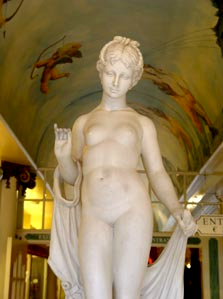
More artistic than skanky - this sums the whole place up perfectly. Photo from the Sex Museum website.
My Story: Before you say anything about what bright young things get up to these days, trawling round museums dedicated to the dirty act of coitus, let me explain. Not because I think it needs much of an explanation (come on guys, you know you’d have gone too), but just because the last time I came to Amsterdam, I was nine and my parents very deliberately shielded my eyes when we walked past the Sex Museum. And I was quite adamant that I should stand up for my belief of anti-censorship – so in we went.
The thing is, though, it really wasn’t that exciting or stimulating (ha!). It was more about ‘nude’ than ‘naked’, in the sense that many of the items on display were either historical or artistic. A bronze statue. A sword with a penis-shaped hilt. Some old black and white photographs that Verloc might have sold at his shop in Joseph Conrad’s The Secret Agent. Sort of interesting I guess, but it was a bit out-dated, very cheesy, and completely non-erotic. I was hugely disappointed considering I had waited more than a decade for this, but never mind, we did have a giggle. Plus of course, it was the fact that I made my stand and pulled the wool from my eyes that mattered.
Misc.
Canal Tour (with Tours and Ticket)
Phone: 020 420 4000
Website: www.tours-tickets.com/cruises
My Story: I know getting on a canal tour is just about as touristy as you can get, but hey, it had shelter and I wasn’t, at that point, confident enough to get on a bike (I have since improved drastically and had my first fall – so I’m invincible now!) But looking back, we shouldn’t have done it because it was actually quite a terrible way to waste our time. I do, however, have to point out that our experience was particularly marred by two main factors. Firstly, most of the boat was taken up by a huge group of Jews – all adults, mind – who spent the entire time running around, shouting, or shushing each other really loudly. Their tour guide also rudely insisted on talking over the English presentation, and so we learnt absolutely nothing about the city. I’m not being funny and I’m certainly not being racist, but it was extremely disturbing. And the second reason was that the woman in front of us insisted on having the window wide open despite the cold. She said she was going to take photos but her camera disappeared from view after one shot.
I therefore admit that my review of the tour is extremely biased, and it might be worth doing further research before you make your decision about whether to go or not. Other people have probably had much better experiences (like the Jews, perhaps?) but do, if you’re still keen on going, make sure that you go on a nice day, sit near the front where the speakers are located, and be prepared that it could potentially turn out to be the worst thing you’ve ever had to pay for.
That said, I did spot a boat named ‘Viagra’ along the way, which cheered me up for a good few minutes.
Red Light District (map)
My Story: Not much of a story to tell here really, although I’m sure others will have plenty. The thing that struck me most about this infamous district, incidentally, was how pretty it looked as the sun set and the windows’ lights were reflected in the canal. Of course, that’s not what most people go there for, but I just thought I should mention the other side that gets less attention. Yes there were red lights, yes there were skimpily dressed girls licking their lips seductively from behind glass windows, yes there were a lot of ads for various shows and more sex toys than you ever knew existed. And yet I just couldn’t help but feel like it was all for show. It was Amsterdam trying to flaunt how badass and liberal and hot a city it is, but the result just seemed a bit tacky and fake. It’s just another tourist attraction – albeit one with a bit more flesh on show. Aside from that, your needs will most probably still be satisfied if that’s the kind of fun you’re looking for – and you are willing to haggle for it.
It’s also worth pointing out that you’re not allowed to take photos of the girls or their shop windows under any circumstances, or else your camera may be confiscated, so don’t do it.
Alto Jazz Cafe
Address: Korte Leidsedwarsstraat 115 (map)
Phone: 020 626 3249
Website: www.jazz-cafe-alto.nl
My Story: Having spent a good full day floating in various coffeeshops, I really wasn’t in the mood for a night out. I concluded, however, that I must see the city after dark if I were to truly experience it, and so grudgingly stepped out into the cold. I’m happy to report that it was definitely worth it.
A friend of mine recommended Alto as being the best and most authentic jazz club in the city, and it turns out that he was not alone in thinking that – I met a lovely hippy couple from Sweden who told me that they used to live in Amsterdam and have been coming to Alto for more than ten years. Plus it was packed on a Sunday night, which is always a good sign. It’s easy to see why everyone loves this snug little place though, as the lights were low, the bartenders were hot, and the small stage provided a very intimate setting for both the live band and the crowd. After a few drinks some people even got up to dance (or ‘dance’ in the case of one particularly jolly gentleman, who spent the evening waving his arms around like a very energetic imitation of Her Majesty). The atmosphere was perfect – fun, relaxed and sociable. I would therefore conclude that Alto was by far the most enjoyable part of our trip, and I’d love to visit again some day.
The live band performing that night consisted of local trumpeter extraordinaire Saskia Laroo and her fantastic boys Maarten (bass), Will (drums) and Daan (piano). My interview with them will be coming soon so watch this space!
Other Touristy Things You Might Fancy…
Van Gogh Museum: Home to the largest collection of the renowned artist’s works, including ‘Sunflower’ and ‘The Potato Eaters’.
Rijksmuseum: Apparently better than the Van Gogh Museum according to locals, the Dutch National Museum houses many great works by artists such as Rembrandt and Vermeer.
Heineken Experience: An interactive way to learn about Heineken – free beer included, I hear.
Anne Frank House: The house in which Anne Frank and her family lived and hid until they were discovered by the Nazis.
Molen van Sloten: The only functioning windmill in Amsterdam that is fully open to the public.
